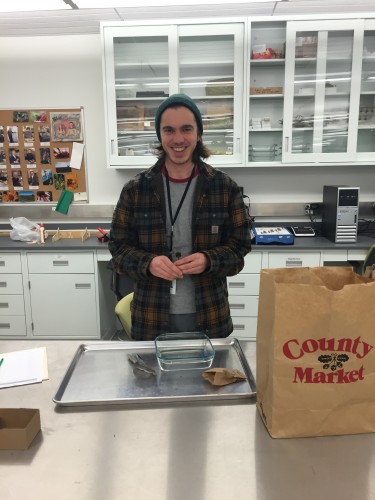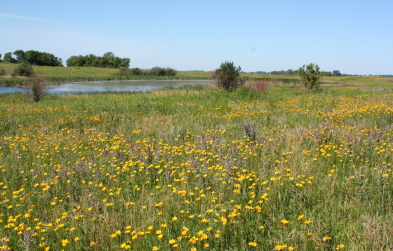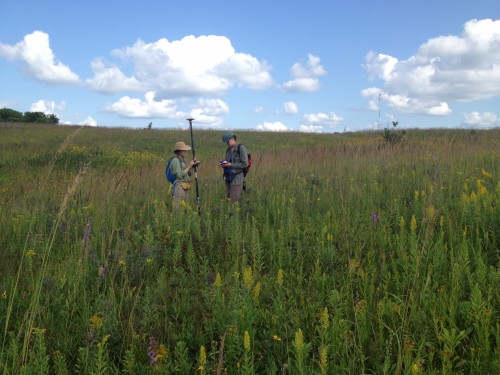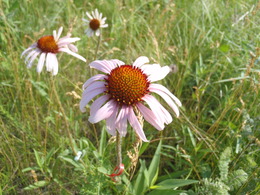|
|
I’ve been helping out around the lab since the fall, but this is my first post on the Flog, so I’ll go ahead and introduce myself. I’m Gordon, and I’m a senior at Northwestern University studying Environmental Science and Chemistry. I have the awesome opportunity to conduct an independent study here at The Echinacea Project—not only will I learn research techniques and scientific writing skills, but I’m also able to get class credit for my research, allowing me to devote more time to the project.

Me with one of the many heads I’ve dissected
The main focus of my research is how fires affect the reproductive success of Echinacea. The existing scientific literature suggests that fires (or a lack thereof) redistribute resource availability, giving a survival advantage to certain species of plants. For example, a fire can burn tall prairie grasses to the ground, allowing shorter plants to access sunlight and contributing to their survival. In areas where prairie fires are suppressed, which includes many locations where prairie remnants exist today, it is thought that plants that benefit from fires will become scarcer. However, there is scant scientific literature regarding how fires influence the reproductive success of prairie plants.
At Staffanson Prairie Preserve, prescribed burns are conducted every five years, providing an ideal setting in which to conduct this observational study. I will be examining at plants that flowered both in 2015 (a non-burn year) and in a previous burn year. By comparing their reproductive success in both the burn year and non-burn year, I hope to gain an understanding of what influence fires may have on Echinacea reproduction. The measures I will use to study reproductive success will include: achene count, which indicates resource availability and reproductive effort; style persistence, which measures the pollen availability and limitation; seed set, which measures the success rate of seed production; and fecundity, which serves as an indication of total reproductive success.
Stay tuned for weekly updates about my procedure and progress over the next several months!
For her RET project, Lea gathered data to study the relationship between flowering density and seed set. She worked at Staffanson Prairie Preserve, which appears to have higher flowering density in burn years than non-burn years. This year, 2015, was a non-burn year. Lea and Team Echinacea kept track of the style persistence of about 50 individuals for which we have seed set information from prior burn years. These individuals were harvested and their achene count and seed set will be assessed in winter 2016 by Gordon Younkin, an undergraduate intern from Northwestern University. Gordon will work to build a model of seed set in Staffanson in a non-burn year and aims to compare this model to a burn year.

Site: Staffanson Prairie Preserve
Start year: 1996
Location: Staffanson Prairie Preserve
Overlaps with: phenology in remnants, phen for aii
Products: Lea is developing a dataset and lesson plan for high-school students to compare individual plants’ style persistence in burn years and non-burn years to test hypotheses about seed set in high- and low- flowering density. This lesson will introduce students to R and its use in data management and statistical analysis.
Read other flog posts about this experiment.

This project builds on the Echinacea Project’s longitudinal demographic dataset from remnant prairies to explore the role fire plays in the reproduction of Echinacea angustifolia. In 2014, Claire Ellwanger and Jared Beck monitored the daily phenology of 324 flowering heads belonging to 143 plants that flowered in 2014 and gathered demographic information on 523 individuals within burned and unburned portions of Staffanson Prairie Preserve. Additionally, we collected 84 flower heads to assess seed set in 2014. Using this data and the data collected in previous years, we will integrate spatial, phenological, and demographic information from individuals at Staffanson Prairie to build a longitudinal database and evaluate the effects of prescribed fire on Echinacea survival and reproduction.
Our methods for collecting demographic and phenological data were identical to the procedures used in the projects “EA demo”, “phen in six remnants,” and “phen for Aii” except that we mapped nearest flowering neighbors. We mapped out to the 7th nearest flowering neighbor for focal plants on the SPP transect. Jared wrote an R function (looky) to streamline searching for nearest neighbors in the field. This function specifies a search radius and creates a map of all mapped flowering plants for a given site within that search radius. In addition to using looky, we targeted our searches near the edges of Echinacea clusters and where there were known Echinacea plants near the transect to increase the efficiency of our searches.
Read previous posts about this experiment.
Start year: 2007
Location: Staffanson Prairie Preserve
Products: Survey, demography, phenology, and style persistence datasets need to be made readyR. The Echinacea heads collected in 2014 are being processed at the Chicago Botanic Garden.
Overlaps with: EA demo, phen in six remnants, and phen for Aii
This afternoon the whole team ventured out to Staffanson prairie and collected demographic information on Echinacea plants. In addition to the 140 plants already flagged for phenology, we staked and collected data on roughly 200 additional plants!
While we put a substantial dent in the demography we need to do at Staffanson this afternoon, we still have a ways to go. Between 2010 and 2014 Team Echinacea mapped 1074 points, including 649 unique tag numbers. We will revisit all of these plants this summer in order to continue building a longitudinal demographic database.
I attached a graph to illustrate the temporal distribution of Echinacea tags at Staffanson. Note that all tags in the 19000s were placed in 2014, tags in the 18000s were placed in 2013, and tags in the 17000s were placed in 2012, etc. We have 410 unique tag numbers placed between 1996 and 2009 on our list of plants to stake!
sppDemoSummary.pdf
With nearly all of our plants mapped at Staffanson, Claire and I have taken a little sneak peak at the spatial data we collected (it’s like Christmas in July, we just couldn’t wait to open our presents). I have included a graph depicting the the average distance from each flowering Echinacea plant to its kth nearest neighbor. The distribution of distances were nearly all skewed right so I plotted the natural log-transformed distances +/- the SE. There are clear differences between the East and West units (note that the East unit was burned in 2014).
knnspp2014.pdf
Although this graph does not necessarily reflect distances to the true nearest flowering neighbors (we only included distances for plants mapped on our sampling transect), these data are consistent with our hypothesis that fire increases the density of flowering Echinacea. More to come soon…
Today Jared, Will and I spent the afternoon at Staffanson Prairie Preserve wrangling the blooming Echincea with flags and twist ties while also updating our flowering map of 2014. We’re working to find plants that were used in phenology studies in previous years so we can look at how a single plant’s flowering pattern changes over time. Here’s a map of the plants we’ve found so far this year, overlaid on multiple years of previously mapped plants.
staffmap.pdf
While out and about in Staffanson it’s easy to get drawn into the morphing landscape as new species begin to bloom. Here’s a picture of one of our favorites, Delphinium carolinianum.

Today the whole team was busy mapping and monitoring the phenology of Echinacea at numerous remnants. Although mosquitoes, gopher holes, and construction crews conspired against us, we were able to complete all monitoring before a bout of afternoon rain.
Here is a quick and dirty map of flowering Echinacea plants at Staffanson prairie that were mapped between 2011 and 2013. Please note that west, rather than north, is “up” on this map (the unusual orientation of this map is just for my convenience)…
sppmap

This afternoon Claire and I struck out for Staffanson Prairie to check on the flowering status of Echinacea. Over the course of the summer, we will be monitoring the phenology of mapped plants at Staffanson to examine how fire influences mating opportunities and reproductive success in Echinacea populations. We found several plants getting ready to flower (including Echinacea #7553 photographed by Claire) but we are still a week away from floret emergence. Although Echinacea bracts were closed tight, we did find numerous other species in bloom such as Wood Lily (Lilium philadelphicum), Yellow Sundrops (Calylophus serrulatus), Prairie phlox (Phlox pilosa), Prairie Alumroot (Heuchera richardsonii), Silverleaf Scurfpea (Pediomelum argophyllum but always Psoralea to me), and the aptly named Mountain Death Camas (Zigadenus elegans).
This morning, I went out to Staffanson to collect flowering phenology data and saw my first flowering Echinacea of the summer! Some had started flowering yesterday but a few started today. Awesome! 😀

Sarah B
There was one project we did not get to this year. In the summer of 2012, field intern Kelly Kapsar observed flowering times for Echinacea in burned and unburned areas of the Staffanson prairie preserve. At the end of the summer, she collected the flowering heads in order to assess the relationship between flowering time and seed set. Various students have worked on aspects of the project. In November, Mindy Runge and Ale Mendoza (Lakeforest College) extracted and weighed achenes (click here to see their poster). In December, Marie Schaedel (Carleton College) weighed additional achenes and assessed our methods of judging whether an achene is full or empty (click here to read her results ). Most recently, Jill Pastick (Lakeforest College) finished extracting achenes and helped organize the collection.
These steps (extracting and weighing achenes) allow us to draw a relationship between flowering time and seed set (i.e. the proportion of full vs. empty achenes). The next step of this study will be to germinate the achenes and plant them in the field. Unfortunately, that will have to wait until next year. In the meantime, the collection of weighed and organized achenes will be stored in the freezer.

|
|







